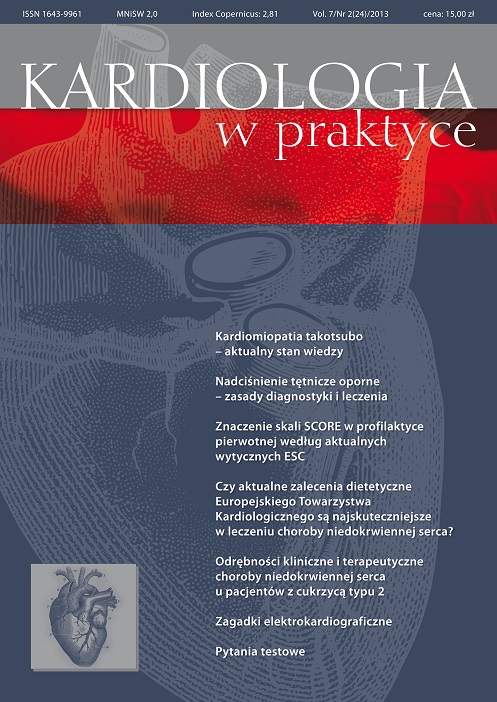Znaczenie skali SCORE w profilaktyce pierwotnej według aktualnych wytycznych ESC Artykuł przeglądowy
##plugins.themes.bootstrap3.article.main##
Abstrakt
Choroby sercowo-naczyniowe są wiodącą przyczyną zgonów na świecie. Prowadzą one do pogorszenia jakości życia, niepełnosprawności, niezdolności do pracy oraz zwiększenia kosztów opieki medycznej. W 1969 r. WHO nazwała CVD głównym zabójcą, z jakim ludzkość miała do czynienia. Od 1991 r. obserwuje się w Polsce obniżanie wskaźników śmiertelności z powodu CVD. W ocenie ryzyka sercowo-naczyniowego nieocenionym narzędziem jest skala SCORE, którą rekomendują aktualne wytyczne ESC dotyczące prewencji CVD.
Pobrania
##plugins.themes.bootstrap3.article.details##

Utwór dostępny jest na licencji Creative Commons Uznanie autorstwa – Użycie niekomercyjne – Bez utworów zależnych 4.0 Międzynarodowe.
Copyright: © Medical Education sp. z o.o. This is an Open Access article distributed under the terms of the Attribution-NonCommercial 4.0 International (CC BY-NC 4.0). License (https://creativecommons.org/licenses/by-nc/4.0/), allowing third parties to copy and redistribute the material in any medium or format and to remix, transform, and build upon the material, provided the original work is properly cited and states its license.
Address reprint requests to: Medical Education, Marcin Kuźma (marcin.kuzma@mededu.pl)
Bibliografia
2. Perk J., De Backer G., Gohlke H. et al.: European Guidelines on cardiovascular disease prevention in clinical practice (version 2012). The Fifth Joint Task Force of the European Society of Cardiology and Other Societies on Cardiovascular Disease Prevention in Clinical Practice (constituted by representatives of nine societies and by invited experts). Developed with the special contribution of the European Association for Cardiovascular Prevention & Rehabilitation (EACPR). Eur. Heart J. 2012; 33(13): 1635-701.
3. De Backer G., Ambrosioni E., Borch-Johnsen K. et al.: European guidelines on cardiovascular disease prevention in clinical practice. Third Joint Task Force of European and Other Societies on Cardiovascular Disease Prevention in Clinical Practice. Eur. Heart J. 2003; 24(17): 1601-1610.
4. European Association for Cardiovascular Prevention & Rehabilitation; Reiner Z., Catapano A.L., De Backer G. et al.: ESC/EAS Guidelines for the management of dyslipidaemias: the Task Force for the management of dyslipidaemias of the European Society of Cardiology (ESC) and the European Atherosclerosis Society (EAS). Eur. Heart J. 2011; 32(14): 1769-818.
5. Mosca L., Banka C.L., Benjamin E.J. et al.: Evidence-based guidelines for cardiovascular disease prevention in women: 2007 update. Circulation 2007; 115(11): 1481-501.
6. Graham I., Atar D., Borch-Johnsen K. et al.: European guidelines on cardiovascular disease prevention in clinical practice: full text. Fourth Joint Task Force of the European Society of Cardiology and other societies on cardiovascular disease prevention in clinical practice (constituted by representatives of nine societies and by invited experts). Eur. J. Cardiovasc. Prev. Rehabil. 2007; 14(Suppl. 2): S1-113.
7. Mancia G., De Backer G., Dominiczak A. et al.: 2007 ESH-ESC Practice Guidelines for the Management of Arterial Hypertension: ESH-ESC Task Force on the Management of Arterial Hypertension. J. Hypertens. 2007; 25(9): 1751-62.
8. World Health Organization, Regional Office for Europe. The Prevention and Control of Major Cardiovascular Diseases. Report of a Conference.1973. Report No Euro 8214.
9. Capewell S., O’Flaherty M.: Rapid mortality falls after risk-factor changes in populations. Lancet 2011; 378: 752-753.
